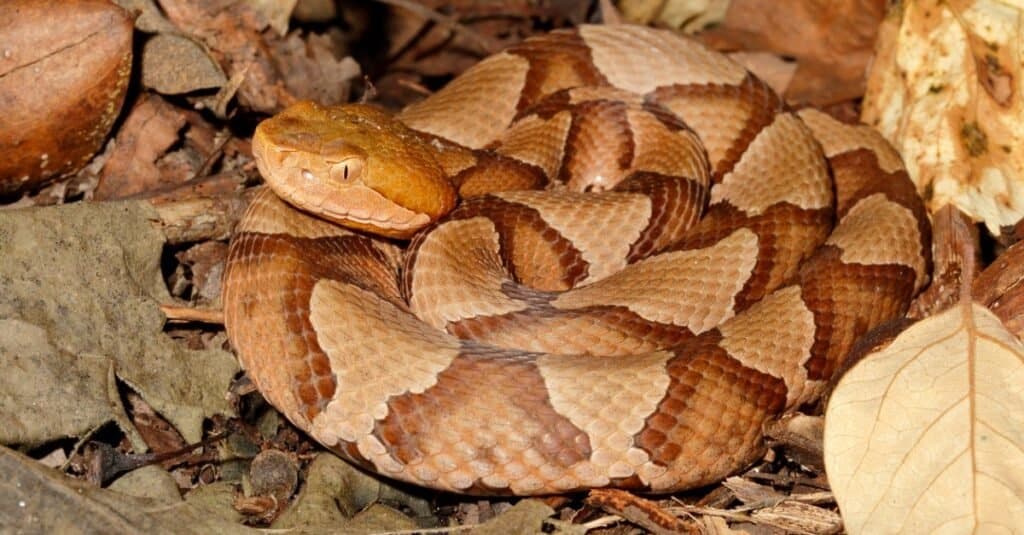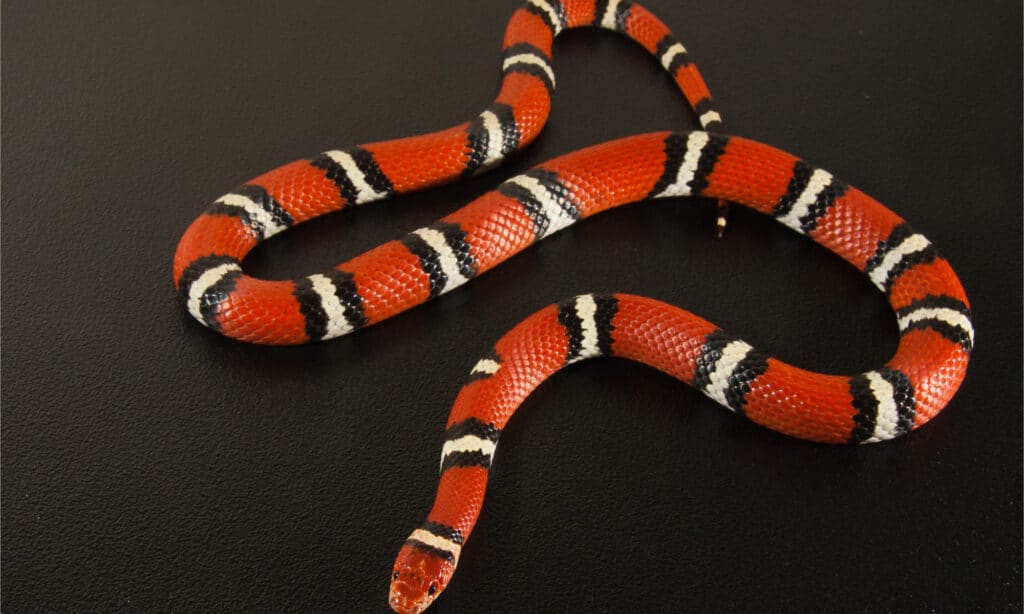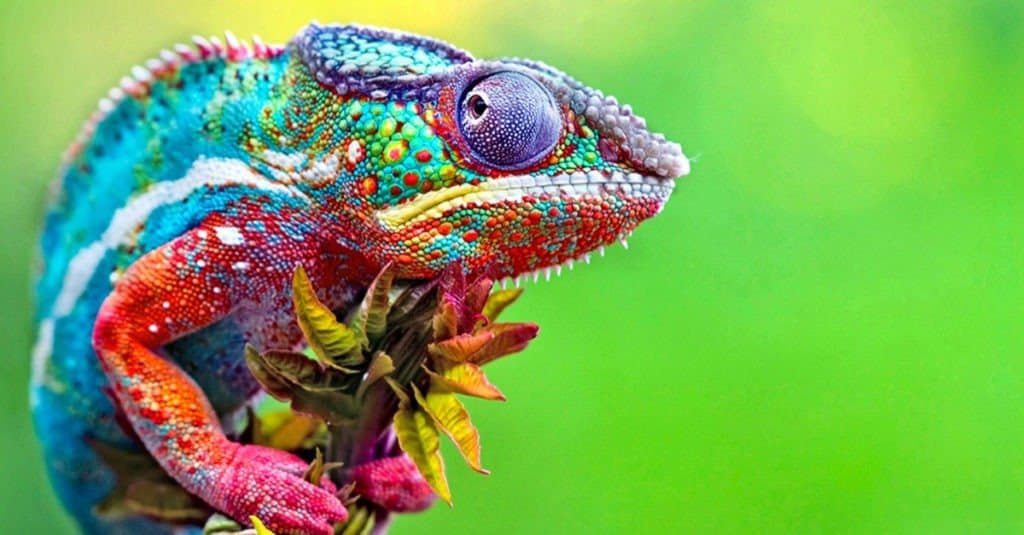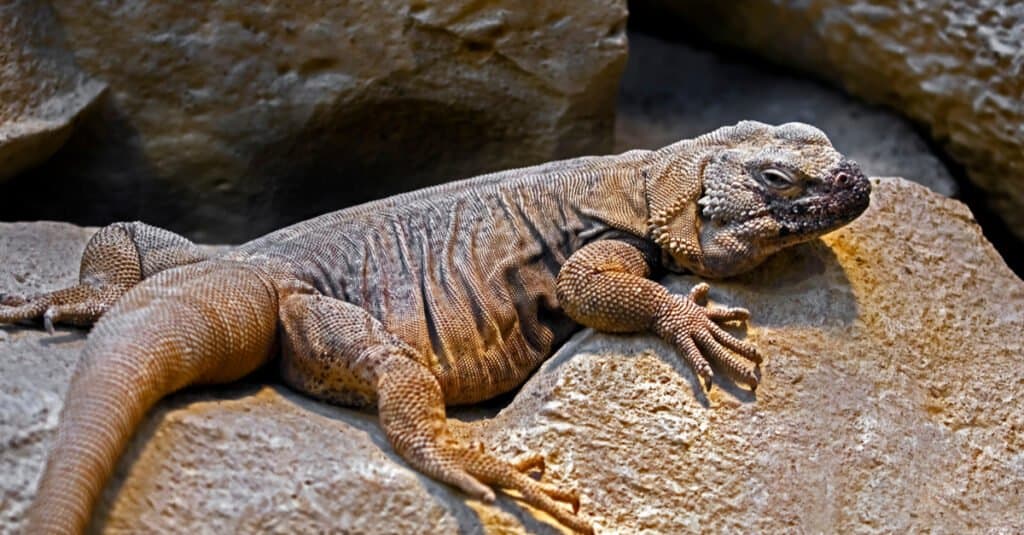Animals use all sorts of camouflage techniques to hide in plain sight. The gaboon viper is an excellent example. Its vivid pattern helps break up its body shape in the dense leaf litter of its native habitat, making it nearly invisible until you step on one.
What is Disruptive Camouflage?
Disruptive camouflage is a common sight in nature if you can spot the animals that use it. Animals that use disruptive camouflage are made nearly invisible by patterns and colors that you might think should make them exactly the opposite.
A pattern that looks like fall leaves may look vivid when you hold it against a solid-colored background, yet place it up against those same leaves, and you’ll never see it. For example, you’ll find that zebras bunch together when a predator approaches. Their stripes make it impossible to tell their heads from their tails, and all the animals in the herd blur together. Other examples include zebras, giraffes, reticulated pythons, and copperhead snakes.
About the Copperhead

A Northern Copperhead (Agkistrodon contortrix mokasen) lying on leaf litter, taken in New Jersey.
©iStock.com/David Kenny
The copperhead snake is a venomous pitviper native to the southern United States. There are two accepted species, the eastern copperhead (Agkistrodon contortrix) and the broad-banded copperhead (Agkistrodon laticinctus). These snakes aren’t as dangerously venomous as their close cousin, the water moccasin (Agkistrodon piscivorus). However, their bite still requires medical attention.
Copperhead snakes use the same approach to camouflaging as a gaboon viper or a zebra. The copperhead’s alternating dark brown/burgundy pattern over a base of light brown serves as camouflage that closely matches the colors and patterns created by the dry leaves where it lives.
While they’re not typically aggressive, their habit of hiding in plain sight makes the copperhead a snake that you must look out for when you’re out in nature.
Can You Spot the Copperhead Snake?
Snakes are inherently difficult to spot in the wild because they can slither silently through tree branches, under the leaves, and even under the ground. Their stealthy nature and excellent camouflage make them easy to miss.
This photo, credited to Jerry Davis of Texas, exemplifies the copperhead’s camouflage. Finding this snake is like finding a needle in a haystack. Can you spot it in the below image?
The snake is almost dead-center in the photo. Do you see it? This particular copperhead species, Agkistrodon contortrix, has a pattern that looks like an hourglass when viewed from above. However, all you can see in the photo is the snake’s side, which shows the lower half of the hourglass. It looks like a curvy line of chocolate kisses with a light-colored center.
Revealing the Copperhead Snake in the Photo
It may take a few minutes to spot the snake in the leaves, which should tell you why experts say you should always hike with a stick. Using it to gently move the leaf litter around before you step helps prevent stepping on a spicy noodle like this copperhead.
Look at the marked-up image below if you haven’t found it yet. Once you see it, you can’t unsee it!
What Other Forms of Camouflage are there?

The white coat of the seal pup makes it difficult for predators to be able to spot it on the ice
©Vladimir Melnik/Shutterstock.com
Concealing Coloration: In this case animals simply take on a color which blends into that of their surroundings. An example is the white fur of baby harp seals which not only keeps them warm while they develop blubber but also makes it difficult for predators to spot them.

Unlike coral snakes which have yellow bands against red, milk snakes’ black red bands are followed by black
©Nathan A Shepard/Shutterstock.com
Mimicry: This refers to the art of disguise in nature where a member of one species takes on the appearance of another so as to be able to better evade predators. Batesian mimicry is one such example and involves a species resembling one which is venomous or capable of inflicting harm. The resemblance of milk and kingsnakes to coral snakes can be seen as an example of Batesian mimicry.
What Other Reptiles Are Capable of Camouflage?

Chameleons are capable of changing their color thanks to the presence of crystals in their skin
©Graphics Illuminate/Shutterstock.com
Chameleons: Scientists have found that these tropical lizards are capable of swapping one color for another depending on their surroundings, do so by means of special crystals in their skin. These crystals reflect varying colors of light depending on their sizes. By compressing these cells or releasing them, the reptiles reflect different wavelengths of light changing their skin color as a result.

By lying on rocks similar to their coloration, lizards can make it difficult for predators to spot them
©Mikhail Blajenov/Shutterstock.com
Aegean wall lizards: Few things are more delightful for these reptiles than lying on a warm rock and soaking in all that sunshine. Except that doing so comes with the risk of a ravenous, winged predator in search of a tasty morsel. These savvy reptiles have worked out how to get that sunshine by selecting rocks closer to their natural coloring. All the better to avoid becoming dinner for a hungry avian.
Up Next
- Copperhead
- How to Identify a Copperhead: The 5 Step Guide (With Pictures)
- 10 Camouflaged Snakes That You’ll Never See Coming!
The photo featured at the top of this post is © DnDavis/Shutterstock.com
Discover the "Monster" Snake 5X Bigger than an Anaconda
Every day A-Z Animals sends out some of the most incredible facts in the world from our free newsletter. Want to discover the 10 most beautiful snakes in the world, a "snake island" where you're never more than 3 feet from danger, or a "monster" snake 5X larger than an anaconda? Then sign up right now and you'll start receiving our daily newsletter absolutely free.
Thank you for reading! Have some feedback for us? Contact the AZ Animals editorial team.






